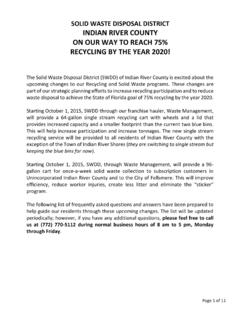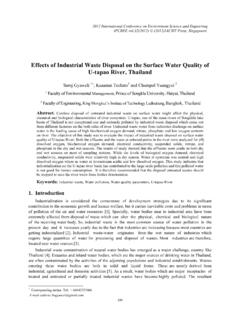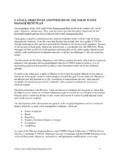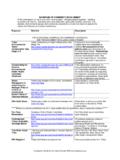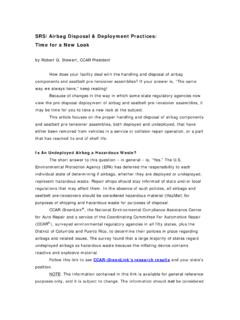Transcription of Health Care Waste Management in Uganda A Case Study of ...
1 International Journal of Waste Management and Technology Vol. 2, No. 2, April 2014, PP: 1 - 12, ISSN: 2327 - 8757 (Online). Available online at Research article Health care Waste Management in Uganda -A Case Study of Soroti Regional Referral Hospital Lawrence Muhwezi, Paul Kaweesa, Faisal Kiberu and I. Luke Enyenu Eyoku Department of Civil and Building Engineering, Faculty of Engineering, Kyambogo University, P. O. Box 7181, Kampala, Uganda . Corresponding author: Email: This work is licensed under a Creative Commons Attribution International License. _____. Abstract It has been recognized world over that Health care Waste (HCW) if not properly managed is a potential of disease transmission and puts Health care workers, patients and the general public at a risk.
2 This Study investigated the problems of Waste Management in Soroti Regional Referral Hospital (SRRH) and proposed solutions to mitigate them. This was done through observation, interviews, studying the available policies, guidelines and legislature. Data on Waste generation rate and patient attendance was also collected and analysed. The Study identified the causes of poor Waste Management as poor segregation of Waste , lack of Waste Management plan, inadequate Waste Management and coordination structure, ineffective and inefficient incineration equipment and lack of comprehensive Waste Management policies and guidelines.
3 The current average Waste generation rate at SRRH was determined to be There is need to have a good and comprehensive Waste Management policy, guidelines and plan which will provide a proper Waste Management structure to alleviate the problem. Some of the proposed recommendations may be implemented at the facility level as short term while others at the national level may require significant funding and time. It is hoped that there will be improved efficiency in Health care Waste Management , improved working and living environment at the hospital, reduced risk of infection and will create a good image of the hospital.
4 Copyright IJWMT, all rights reserved. Keywords: Health care Waste , Management , segregation, hospital. _____. International Journal of Waste Management and Technology Vol. 2, No. 2, April 2014, PP: 1 - 12, ISSN: 2327 - 8757 (Online). Available online at Introduction Improper HCW Waste Management can jeopardize care staff, employees who handle Healthcare Waste , patients and their families and the neighbouring population. In addition, the inappropriate treatment or disposal of such Waste can lead to environmental contamination or pollution. Improper disposal of medical Waste may lead to damage to humans by sharp instruments, diseases transmitted to humans by infectious agents and contamination of the environment by toxic and hazardous chemicals [1], [2] and [3].
5 Due to its content of hazardous substances, healthcare Waste poses serious threats to environmental Health [4] and [5]. The hazardous substances include pathological and infectious material, sharps and chemical wastes [6], [7] and [8]. Health care Waste , medical Waste , biomedical Waste and hospital Waste are terms which are used interchangeably. The terms cover all wastes produced in Health care or diagnostic activities [9]. It is also defined as all the Waste generated by Health care establishments, research facilities and laboratories [10]. Improper medical Waste Management is alarming in Uganda and it poses a serious threat to public Health .
6 In developing countries, medical Waste has not received much attention and it is disposed of together with domestic Waste [11] and [12]. Medical Waste can be infectious or non-infectious. It acts as an agent in the transmission of infections. This is because it contains micro-organisms which can be communicated by invasion followed by multiplication in body tissues. These so transmitted pathogens can cause disease or diverse Health impacts to humans [13]. Improper healthcare Waste Management puts the patients, healthcare workers, Waste handlers and community at risk both in terms of risks from inadequate storage, transportation and disposal of infectious Waste and from the environmental risks arising from burning hazardous wastes in open pits or badly maintained incineration equipment.
7 In Uganda , a Study conducted in July 2003 it was established that more than 45% of the Health care providers interviewed reported at least one needle stick injury in 12 months. The Study further established that 38% of the Health facilities visited had sharps and other wastes on ground or in other un-supervised areas, exposing the community to needle stick injuries [14]. Although the Study falls short of giving the number and type of infections that could have been acquired from these injuries and exposures, the possibilities of infections arising from such injuries and exposure cannot be ignored. The current status of Hepatitis B infections in Teso region which is served by Soroti Regional Referral Hospital confirms why Health care Waste Management should be given more attention.
8 According to the Ministry of Health weekly summary of epidemiological reports published weekly in the New Vision newspaper, out of 4 cases reported for the whole country for the week ending 10th February 2013, 3 cases were within Teso region (1 in Kaberamaido district and 2 in Katakwi district). Also out of 4 cases reported for the whole country for the week ending 17th February 2013, all the 4 cases were from Katakwi district in Teso region. Globally, it is estimated that accidents caused by sharps accounts for 66,000 cases of infection with the hepatitis B virus, 16,000 cases of infection with hepatitis C virus and 200 to 5,000 cases of HIV infection amongst the personnel of Health - care facilities [9].
9 In France in 1992, eight cases of HIV infection were recognized as occupational infections; two of these cases, involving transmission through wounds occurred in Waste handlers [10]. Due to infections which can arise from improper HCW Management , it was pertinent to undertake this Study . One of the problems Uganda faces today is the improper handling and disposal of solid wastes. During the evaluation of injection safety and Health care Waste Management (HCWM) in Uganda , it was found that 92 percent of Waste handlers have poor Waste disposal methods, percent have acceptable Waste disposal methods and percent have good Waste disposal methods [15].
10 Hospital Waste Management is one of the biggest challenges SRRH is facing in addressing the growing quantity of Waste generated. In Uganda , Waste generation in hospitals averages 92 Kg of general and HCW per day, 40 percent of which is hazardous. According to [16], a level IV Health center (HC) generates average of 42 Kg per day while level III and level II HC generate 25 Kg and 20 Kg per day respectively. This report agrees with a Study conducted in 23 heath facilities in October 2007 by Ministry of Heath Kenya. It was found that 39% of wastes generated were infectious and 61% non-infectious Waste . The Study further found that sharps Waste averaged , infectious Waste , non-infectious Waste and food Waste giving a total of Another research conducted on Management and generation of HCW in two hospitals in Kampala found that infectious Waste from Nsambya hospital was per patient per day and per patient per day in Mulago hospital [17].
